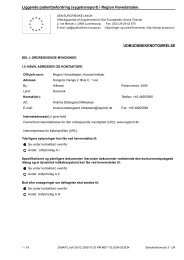Territorial Review Copenhagen - Region Hovedstaden
Territorial Review Copenhagen - Region Hovedstaden
Territorial Review Copenhagen - Region Hovedstaden
You also want an ePaper? Increase the reach of your titles
YUMPU automatically turns print PDFs into web optimized ePapers that Google loves.
114<br />
governments and the majority of local governments engaged in stimulating<br />
indigenous economic activity, promoting employment within their areas and<br />
securing a higher level of taxable income. Danish regional policy has been<br />
described as a form of decentralised industrial policy, and economic growth<br />
and competitiveness has almost exclusively been pursued by a network of<br />
small single-function development bodies (Halkier, 2004).<br />
From the early 1990s, Denmark adopted the cluster approach to regional<br />
economic development focusing on large sectoral clusters<br />
(building/construction, bio-health, ICT and food). This policy concentrated<br />
on more specific industry clusters, such as industrial design. Clusters, as a<br />
policy instrument, are now lower on the national agenda, but regional-led<br />
initiatives have been pursuing clusters through ―regional growth<br />
environment‖ programmes, described as ―a co-operation between<br />
companies, research and educational institutions, distributors of<br />
technological knowledge and other relevant actors” (Jensen, 2004: 3). A<br />
regional growth programme was funded by central government from 2002<br />
(DKK 10 million per county over three years) with funding matched by<br />
regional collaborators.<br />
…and urban renewal policy has become less top down-oriented and<br />
more area-focused<br />
Over the last decades, urban renewal policy in Denmark has undergone<br />
substantial change. Since the beginning of the new millennium, it has<br />
involved local stakeholders and citizens, and used targeted and holistic,<br />
rather than universal, sectoral programmes. Increasing use is made of intergovernmental<br />
contracts as a form of policy regulation. An example of this<br />
new approach is the neighbourhood improvement scheme, Kvarterloft,<br />
launched in 1997 to solve a wide range of problems in selected<br />
neighbourhoods in different parts of the country. 1 It builds on new forms of<br />
citizen participation and the involvement of business, organisations and<br />
local associations, with the comprehensiveness of urban problems as a<br />
starting point, and thus requires close co-operation between the different<br />
authorities and sectors of public administration. Specific targets are<br />
established through consultation between central and local governments;<br />
funding takes place in so far as progress is made. There has been a strong<br />
emphasis on inspiration and learning processes. Specific area-based<br />
initiatives were acknowledged as experimental. Many resources were put<br />
into relatively few projects, to serve as examples for later projects. The<br />
experiences of the Kvarterloft programme have been incorporated into the<br />
Urban Renewal Act of 1998. The vision of an urban renewal was pursued<br />
through promotion of quality in urban living, via densification, regeneration,

















